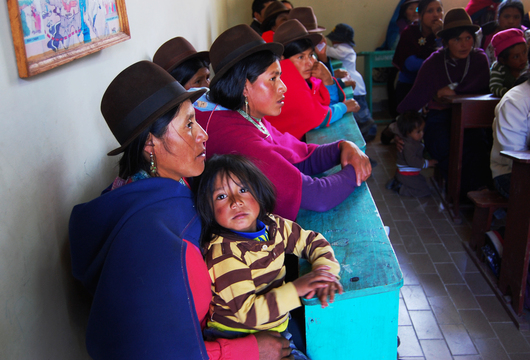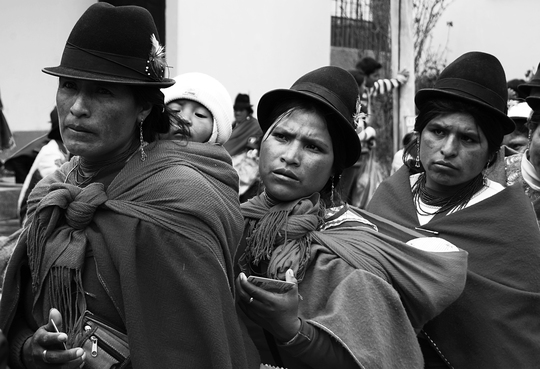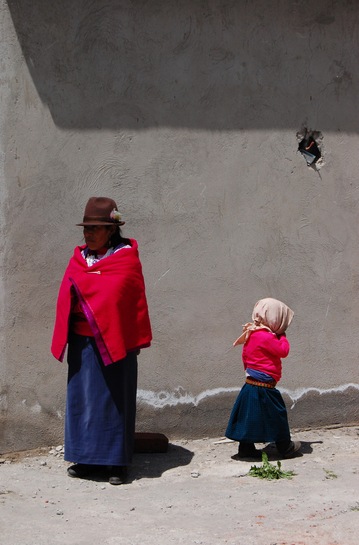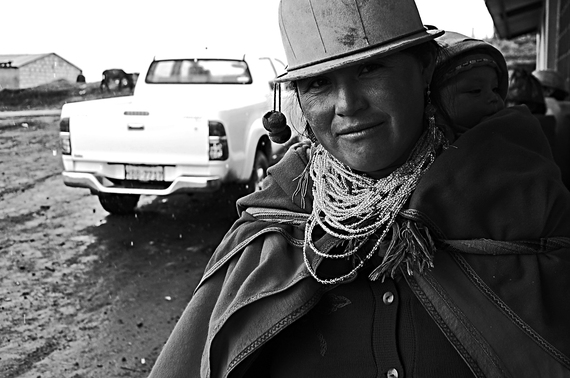
Expanding horizons: despite levels of domestic violence and heavy workloads, rural women are gradually increasing their participation in farmer associations.
QUITO, Ecuador -- Rural Ecuadorian women are saddled with domestic duties, in addition to the responsibilities of tending agriculture and living a rural lifestyle, which often entails withstanding domestic abuse and marginalization. Rural indigenous women in Ecuador experience a disproportionate amount of domestic violence.
In all of Ecuador, six out of ten women have reported domestic abuse at some point in their lives. However, the statistic rises to 68% among rural indigenous women.
Ilaria Lazzarini monitors the United Nations' World Food Programme's project in Chimborazo, working to strengthen local capacities for food security. In her role as a WFP monitor, she frequently travels to rural communities and interacts with program participants. Passionate about photography, Ilaria often brings her camera into these communities to document the rural women whom WFP works to empower. With the series of photos below, Lazzarini "hoped to show the hard life of the rural women and their participation in WFP projects. I admire the strength of these women and the workload that they can withstand." On average, rural women in Ecuador work 23 hours more per week than rural men.
Lazzarini is fascinated by portraits and pictures of people. When she speaks with the rural women, she is often presented with the difficult choice of deciding whether or not to highlight their stories: Lazzarini insists that there is a fine line that she must walk with her photos. Because she is not a member of the rural communities, she says the "major difficulty is finding a balance between the desire to give visibility to a reality by taking a good photo, which in this case is that of indigenous women, and respecting the intimacy of a person's life."
Lazzarini points out that it has been especially difficult in cases when women have recounted their "stories of abuse, rape, and extreme poverty..." Regardless, it seems as if Lazzarini has managed to take photos that strike a fine balance between excessive intimacy and a sense of cool detachment: she shows rural women who have suffered immensely, but who are not downtrodden. They are striving, working to take full advantage of WFP programs that support food security and gender empowerment.
It is often difficult to measure female empowerment in the case of rural indigenous women, according to Lazzarini. However, based on her time in the field, she says that female empowerment in rural communities is clearly something that still "needs a lot of work. Their realities continue to be male-dominated and the biggest community roles continue to be delegated to men."
Nevertheless, Lazzarini insists that women have made considerable progress, that they "are the ones who participate the most in [WFP's] projects, who attend trainings and apply what they've learned to their households... [The women] contribute to improve nutrition and the health of their family and children. Women are the ones who are making these things happen, who, despite their immense workloads, find the time to put to use what they learn from WFP trainings." To accommodate the workloads of rural women, WFP schedules its nutrition trainings on market days and at market locations so that beneficiaries can attend WFP trainings when they go to the market as part of their weekly routine.
Small-scale farmers, many of whom are indigenous women, produce minute quantities with little bargaining power in the market; they often have to sell at prices below production costs. WFP's new model in Ecuador substitutes food rations with fresh food provided by local farmer associations. WFP requires its partner farmer associations to include women, which has encouraged small-scale women farmers to join associations, giving them more market leverage than if they were to continue selling products on their own. These associations help stimulate local production and gradually improve ailing rural economies.
Promoting dietary diversity
From 1988 to 2013, the incidence of anemia in Ecuadorian children under a year old dropped from 66.1% to 62%. However, the problem remains dire and without further nutritional education for both men and women, these precarious health trends will continue to prevail. Malnutrition in Ecuador often is not due to lack of access, but lack of proper education on nutrition.
An extensive study carried out by the International Food Policy and Research Institute (IFPRI) and WFP found that a voucher system rather than hard cash or actual food, was the most effective means of improving dietary diversity in Ecuador. Today, WFP provides vulnerable families who have small children with vouchers in the form of electronic cards that they can use to purchase healthy, diverse foods. In order to receive monthly credit on the cards, families are required to attend monthly nutrition trainings. Part of a WFP-IFPRI study focused on gender violence also discovered that "participation in the program decreased different types of intimate-partner violence, including controlling behavior, moderate physical violence, and severe physical or sexual violence by 38 to 43 percent, regardless of transfer modality (cash, vouchers, or food)."
There is an adage in rural Ecuador that goes, "Even if he hits or even if he kills, he is my husband." WFP is currently working to deconstruct the public perception, particularly among rural populations, that intra-marital violence is the norm. WFP wants to disrupt the culture of violence and make it clear that domestic abuse is a social sickness.
Find the rest of Ilaria's striking photos of the indigenous women of Chimborazo below:
Female participation in markets: the presence of women in markets continues to grow and become more influential.
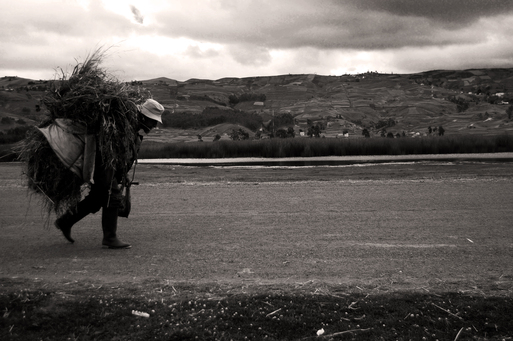
Everything changes: climate change means reduced crops, fewer pastures and, in general, more effort required from farmers to ensure they can feed their families and animals.
Attentive to training: "[Thanks to the trainings,] we know how to better feed the family, handle food, and confront gender violence."
Armed with knowledge: women are trained to use their electronic cards from WFP's food transfer program to diversify family diets.
Different paths: for generations, farmers have lived in the countryside. Today, with new opportunities for education, modernization, and markets, life is divided between the country and the city, people communicating in both Spanish and indigenous Kichwa.
----
All photos are the work of Ilaria Lazzarini/WFP
Visit the website of the World Food Programme at www.wfp.org
Editorial note: quotes from Ilaria Lazzarini have been translated from Spanish to English.

